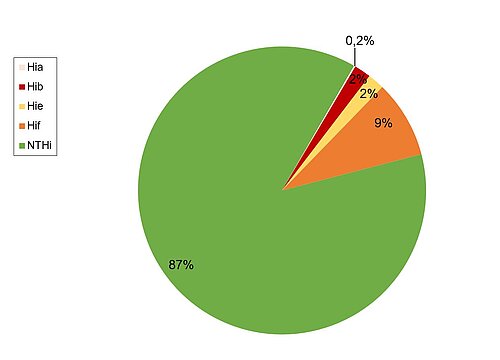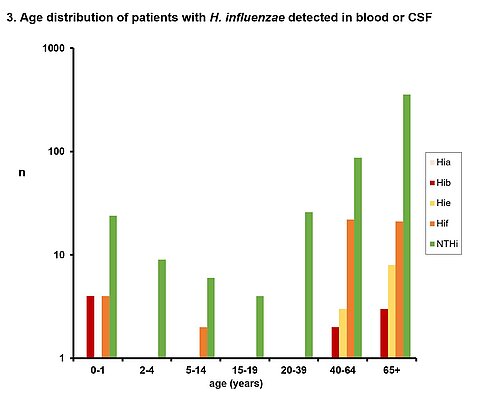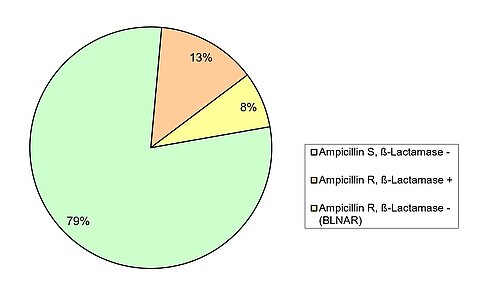Daten 2017 en
Data of the NRZMHi for Haemophilus influenzae 2017
1. Introduction
The tasks of the National Reference Laboratory for Meningococci and Haemophilus influenzae (NRZMHi) assigned by the Robert Koch Institute for the surveillance of invasive Haemophilus influenzae disease include serotyping of clinical isolates from blood or cerebrospinal fluid (CSF) and the detection of antibiotic resistance against β-lactam antibiotics.
In 2017, all in all 707 submissions were analyzed including bacterial isolates from 607 patients with invasive infections. The NRZMHi could confirm the diagnosis Haemophilus influenzae in 594 cases. Among these isolates, 556 derived from blood, 27 from cerebrospinal fluid (CSF) only. We received H. influenzae both from blood and CSF from four patients. Detection of H. influenzae from these materials must be notified according to the German Infection Protection Act (IfSG). Six H. influenzae isolates were found in other normally sterile sites. In one case, an invasive disease was indicated without further information. Seven isolates from normally sterile sites were H. parainfluenzae. One derived from ascites, one from knee joint fluid, five strains were isolated from blood. In six cases, no Haemophilus sp. was detected from the submitted material.
The NRZMHi received H. influenzae isolated from blood or CSF of 587 patients. On the other hand, 805 invasive H. influenzae infections were registered through the statutory notification system in 2017. Since the NRZMHi transmits all laboratory results to the local health authorities in charge, the coverage of the laboratory surveillance can be estimated based on these data. Thus, a coverage of 73% can be assumed for 2017, and 76% for 2016.
As in previous years, the majority of blood or CSF isolates were non-typeable H. influenzae (NTHi, 513 isolates, 86.4 %), followed by Hif as the most frequent capsular serotype (51 cases; 8.6 %). Hib and Hie showed third highest frequency among the serotypes (11 cases each; 1.9 %). Of the rare serotypes, one Hia, and no Hic or Hid were isolated. Among the analyzed cases, the age group most affected was > 40 years (504 cases; 84.9 % of all cases). In addition, a significant percentage of cases (43 cases; 7.2 %) was found in children aged <5 years.
The NRZMHi analyzed the frequency of ampicillin resistance using gradient agar diffusion tests (E-test). One hundred and twenty-two isolates (20.8 %) were ampicillin resistant (MIC > 1 µg/ml), of which 78 (63.9 %) showed β‑lactamase production.
2. Serotype distribution of H. influenzae isolates from blood or CSF in 2017

3. Age distribution of patients with H. influenzae detected in blood or CSF

4. Serotype distribution in Federal States
BW: Baden-Württemberg, BY: Bavaria, BE: Berlin, BB: Brandenburg, HB: Bremen, HH: Hamburg, HE: Hesse, MV: Mecklenburg-Western Pomerania, NI: Lower Saxony, NW: North Rhine-Westfalia, RP: Rhineland-Palatinate, SL: Saarland, SN: Saxony, ST: Saxony-Anhalt, SH: Schleswig-Holstein, TH: Thuringia, abr: abroad.
In three cases, no information about the patient’s place of residence was available (n.n.).

5. Serotype distribution according to site of isolation

6. Ampicillin resistance in isolates H. influenzae from blood or CSF

7. Publications of the NRZMHi on Haemophilus influenzae:
Original Articles
- Lâm TT, Elias J, Frosch M, Vogel U, Claus H. New diagnostic PCR for Haemophilus influenzae serotype e based on the cap locus of strain ATCC 8142. Int J Med Microbiol. 2011 Feb;301(2):176-9.
- Lâm TT, Frosch M, Claus H, Vogel U. Sequence analysis of the serotype-specific synthesis regions II of Haemophilus influenzae serotypes c and d: evidence for common ancestry of capsule synthesis in Pasteurellaceae and Neisseria meningitidis. Research in Microbiology 2011 Jun;162(5):483-7.
- Lâm, T.T., Claus, H., Elias, J., Frosch, M., Vogel, U., 2015b. Ampicillin resistance of invasive Haemophilus influenzae isolates in Germany 2009-2012.Int J Med Microbiol. 2015 Oct;305(7):748-55.
- Lâm, T.T., Claus, H., Frosch, M., Vogel, U., 2016. Analysis of non-typeable Haemophilus influenzae in invasive disease reveals lack of the capsule locus. Clin Microbiol Infect. 2016 Jan;22(1):63.e7-8
Reviews
- Lâm TT, Claus H, Elias J, Hellenbrand W, Imöhl M, Prelog M, Sing A, van der Linden M, Vogel U. Infections with Pneumococci, Menigococci, H. influenzae and Diphtheria in Germany: the RKI Reference Network for Invasive Bacterial Infections (IBI) at the 5th Würzburg Workshop on Epidemiology, Prevention and Therapy for Invasive Meningococcal Diseases 2010 (Meeting Report). Gesundheitswesen. 2011. DOI: 10.1055/s-0031-1286269.
Disclaimer: the above data were generated with federal funds (RKI). Scientific use is prohibited without prior written consent by KLHi or RKI. Commercial use is strictly prohibited. Inclusion of figures or tables in talks or oral presentations is not allowed.

